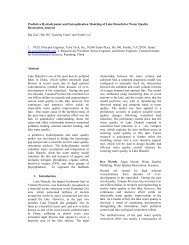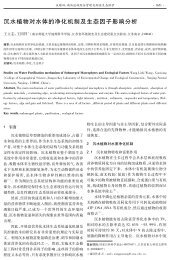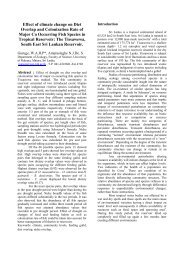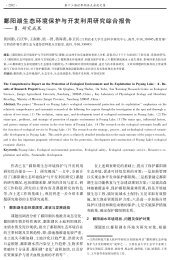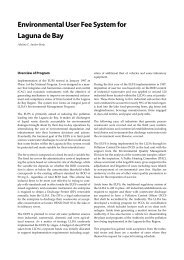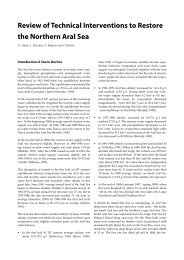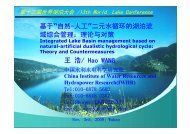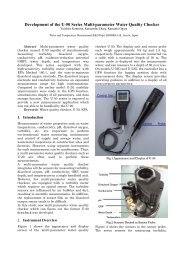Assessment of water quality and quantity of Lake Nakuru, Kenya
Assessment of water quality and quantity of Lake Nakuru, Kenya
Assessment of water quality and quantity of Lake Nakuru, Kenya
You also want an ePaper? Increase the reach of your titles
YUMPU automatically turns print PDFs into web optimized ePapers that Google loves.
Urban discharges into the environment <strong>of</strong> <strong>Nakuru</strong>pose a threat to human <strong>and</strong> wildlife. The practices <strong>of</strong>dumping urban waste in a geologically porous <strong>and</strong>fissured areas <strong>and</strong> discharging poorly or untreatedsewage <strong>and</strong> storm <strong>water</strong> into the lake are questionable interms <strong>of</strong> environmental safety.Contamination <strong>of</strong> the lake with pesticide residues,heavy metals <strong>and</strong> other associated contaminants hasalready occurred <strong>and</strong> appears to be growing problem.Enrichment <strong>of</strong> the lake with nutrients from agricultural<strong>and</strong> urban sources is also occurring giving rise to blooms<strong>of</strong> toxic algae which out-compete the natural biota <strong>of</strong> thelake.<strong>Lake</strong> <strong>Nakuru</strong> can be seen as "the canary in the cage".As the focal point for the interaction <strong>of</strong> a multiplicity <strong>of</strong>environmental effects brought about by natural events<strong>and</strong> anthropogenic activity in its catchment area, itprovides measure <strong>of</strong> the state <strong>of</strong> the environment. Thedegradation <strong>of</strong> the lake should serve as a warning that theenvironment is losing its vitality. The extinction <strong>of</strong> life inthe lake as we know it will be forewarning <strong>of</strong> the fatethat awaits the human occupants <strong>of</strong> the catchment basin.2. Methodology2.1 Data collectionIn situ measurements <strong>of</strong> basic <strong>water</strong> <strong>quality</strong>parameters were carried out from 1992, fortnightly at 8sampling sites in <strong>Lake</strong> <strong>Nakuru</strong> <strong>and</strong> at 5 sites alonginfluent streams <strong>and</strong> sewage channels. The sites are asfollows: (a) <strong>Lake</strong> shore gauges, (b) Mouth <strong>of</strong> RiverNjoro, (c) <strong>Lake</strong>shore drums, (d) Presidents pavilion, (e)Mouth <strong>of</strong> River Makalia, (f) Between Makalia & Nderit,(g) Mouth <strong>of</strong> River Nderit, (h) Kampi ya Nyati, <strong>and</strong> (i)Kampi ya Nyuki. River sampling sites were as follows (j)Baharini springs (k) Town sewage channel (l) RiverNjoro downstream (m) River Makalia downstream (n)River Nderit downstream. Pelagic sampling sites were asfollows: (1) Njoro River Mouth to Kambi Nyati transect(2) Drums to Sarova transect (3) PresidentPavilion to Point E transect, (4) <strong>Lake</strong> Shore gauges-Kampi ya Nyuki transect <strong>and</strong> (5) Makalia to Nderittransect.The lakeshore sites were accessed by wading. Arubber dingy or a fiber glass boat <strong>and</strong> a 15/40 hp Endurooutboard engine were used for sampling 10 mid lakesites located along 5 established transects. In the pelagiczone, <strong>water</strong> samples for vertical limnological pr<strong>of</strong>ileswere collected at different depths (0-4m) using a plasticvan dorn-type messenger closed sample bottle with acapacity <strong>of</strong> 1.25lts. The physico-chemical parameterswere measured in situ using a WTW multiline p4portable meter. The meter is fitted with drift-controlledcombined electrodes, <strong>and</strong> has an accuracy level <strong>of</strong> ±1 <strong>of</strong>measured value. Water transparency was measured usinga calibrated 20cm black <strong>and</strong> white Secchi disc.Parameters monitored were; dissolved oxygen (DO mg/l<strong>and</strong> DO % saturation), electrical conductivity (Ec),salinity, pH, <strong>water</strong> temperature, oxidation-reductionpotential (ORP).2.2 Laboratory analysisLab. analysis was done on replicate samples <strong>of</strong><strong>water</strong> stored in a cool box <strong>and</strong> later transferred to a fridge.Total phosphorus, soluble reactive phosphorus, <strong>and</strong>nitrogen were analyzed, in the lab using a HACHDR/2010 Spectrophotometer. Algal biomass wasestimated by using Chl a. Chlorophyll a (µg/l) wascalculated after reading the absorbance at 665 nm <strong>and</strong>750 nm. This was done after leaving the samples in arefrigerator for 23 hours in an extraction process using94.1 methanol. The Chl a represents 1.5 % <strong>of</strong> the dryweight <strong>of</strong> organic matter (ash-free weight) <strong>of</strong> algae. TheChl a content was multiplied by a factor <strong>of</strong> 67 (St<strong>and</strong>ardmethods, 1998). Algae identification was done using anOlympus compound microscope.Weather data was recorded from 1993 to 2002 at the<strong>Lake</strong> <strong>Nakuru</strong> National Park Weather Station No.9036359, located about 500 meters from the northernlakeshore (0o17’S, 36o04’E). River discharge volumewas measured using a Bargo calibrated OTT C 2 SmallCurrent Meter (Ref: # 10.150.005.B.E at the Baharinisprings (2FC17), R. Njoro (2FC15), R. Nderit (2FC16),R. Makalia (2FC18), R. Ngosur (2FC27). <strong>Lake</strong> levelswere measured at <strong>Lake</strong> <strong>Nakuru</strong> RGS 2FC14.The <strong>water</strong>balance model was developed through analysis <strong>of</strong> lakeconditions - <strong>water</strong> level, salinity, as well as climate <strong>and</strong>surface inflows, calibration, validation, test simulations.Calibration is done by using Excel's "goal seek" tool onRMSE value, adjusting the calibration terms to minimizethat value.3. Results3.1. Water & sediment <strong>quality</strong> monitoring3.1.1 Dissolved oxygenThe dissolved oxygen trends display spatial <strong>and</strong>temporal variations. During the study period, monthlymean DO levels in the lake were 8.7±7.7 mg/l with amedian <strong>of</strong> 7.7 mg/l (Fig 1&2). The highest levels wererecorded at theFig. 1. Mean monthly DO levels (mg/l).2



